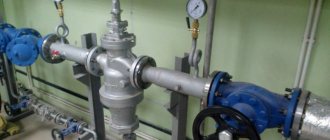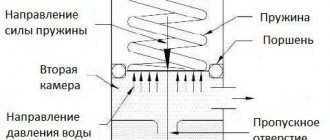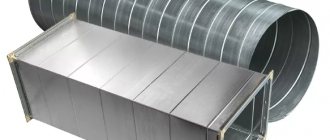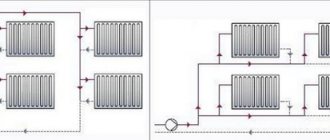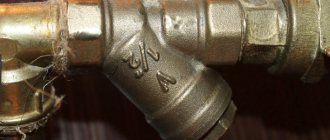In the article we will touch on problems related to pressure and diagnosed with a pressure gauge. We will structure it in the form of answers to frequently asked questions. Not only the difference between the supply and return in the elevator unit will be discussed, but also the pressure drop in a closed heating system, the operating principle of the expansion tank and much more.
Pressure is no less important heating parameter than temperature.
Working pressure in heating systems
Working pressure is the value at which the normal functioning of the heating system is ensured, including the heat source, expansion tank, pump (for more details: “Working pressure in the heating system - standards and tests”). It is calculated in atmospheres (1 atmosphere is equal to 0.1 MPa).
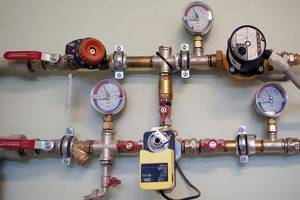
The indicator should be equal to the sum of two pressures:
- static, created by a column of water (when carrying out, they are guided by the fact that there is 1 atmosphere per 10 meters);
- dynamic, due to the operation of the circulation pump and the convective movement of the coolant during heating.
The pressure indicator differs in different heating systems. For example, if the heat supply to a house occurs due to the natural circulation of the coolant (this option is possible in low-rise construction), then the pressure will be only slightly higher than the static pressure. And in systems with forced circulation it is much larger, which is necessary to obtain higher efficiency.
It should be taken into account that the maximum operating pressure of the heating system is determined by the characteristics of its elements. For example, when using cast iron radiators, it should not be more than 0.6 MPa.
The working pressure indicator is:
- for low-rise buildings with a closed layout - 0.2-0.4 MPa;
- for one-story buildings with natural coolant circulation and an open design - 0.1 MPa for every 10 meters of water column;
- for multi-storey buildings - up to 1 MPa.
How to reduce pressure in a gas boiler
Excess pressure is released in the Baxi heating boiler and other models using a machine pump. To do this, follow these steps:
- Drain the entire pipeline.
- Turn off the taps.
- Use a pump to bleed the pipeline to make sure that the coolant is completely drained.
- Air should be released through the air vent.
- Baksi and other boiler models should be pumped until the readings return to normal.
It should be remembered that when starting the circulation pump, hydraulic shocks occur. At first the pressure increases sharply, then it decreases. The correct sequence of installation of components will help smooth out the operation of the equipment. The pump is placed in front of the heating apparatus, the expansion tank is on the return line.
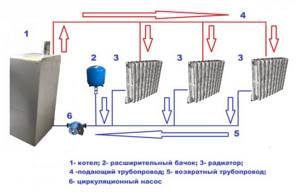
To lower the pressure in the heating line, you need to add water correctly. The system is filled with a small stream, while simultaneously opening the Mayevsky taps to release air pockets. As air is removed from the pipes, the reading on the pressure gauge will gradually decrease.
Do not fill the system with tap water that differs significantly in temperature from the liquid in the circuit.
Temperature changes are detrimental to the heat exchanger. If the tap water is too cold, you need to let the system cool down before topping up. Prevention of increased pressure is periodic cleaning of filters. Magnetic and flush filters require less maintenance. Radiators and other components should be periodically cleaned of scale and dirt.
Preventive measures will extend the operation of equipment and reduce the risk of failures and breakdowns during the heating season.
Pressure drop monitoring
In order for the heating system to operate normally and the risk of an accident to be minimized, it is necessary to monitor the temperature and pressure of the coolant from time to time. For this purpose, a special pressure sensor is used in the heating system, as in the photo.
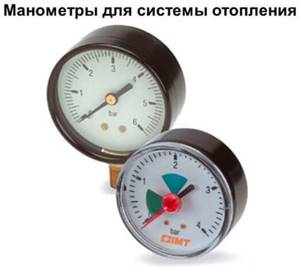
Most often, deformation pressure gauges with a Bourdon tube are used to measure pressure. When determining low pressure, a variety of them can be used - diaphragm devices. After water hammering, such models should be verified, since in subsequent measurements they may show inflated values.
In those systems that provide automatic control and regulation of pressure, various types of sensors are additionally used (for example, electric contact).
The placement of pressure gauges (tapping points) is determined by regulations.
These devices should be installed in the most important areas of the system:
- at its entrance and exit;
- before and after filters, pumps, pressure regulators, mud traps;
- at the exit of the main line from the boiler house or thermal power plant and at its entrance to the building.
These recommendations must be followed even when creating a small heating circuit and using a low-power boiler, since not only the safety of the system depends on this, but also its efficiency, which is achieved through optimal fuel and water consumption (read: “Safety system for heating”). It is recommended to connect pressure gauges through three-way valves - this will allow you to purge, reset and replace devices without stopping the heating system.
Regulator for pressure regulation
To comply with all measures for the safe operation of the heating system, it is necessary to constantly monitor the temperature and pressure of the coolant.
The pressure is monitored using a Bourdon tube pressure gauge . This device has an elastic measuring component, which, under the influence of a compressive load, is deformed in a certain way.
Photo 1. Pressure gauge installed in the heating system. The device allows you to measure pressure readings.
The conversion of changes is reflected in the rotational movement of the hand , showing the exact value on the dial in familiar terms.
Important! After water hammer, pressure gauges need to be checked, as subsequent readings may be too high.
Pressure gauges are installed in the most critical areas of the system:
- at the inlet and outlet of the coolant line (centralized heating);
- before and after the heating boiler (individual heating);
- before and after the circulation pump (forced circulation);
- near filters, related regulators and valves.
How to adjust indicators
There are several proven methods for this procedure:
- Correct design, including hydraulic calculations and installation of pipelines:
- the supply line should be at the top and the return line at the bottom;
- for risers you need pipes of 20-25 mm , and for bottlings - 50-80 mm;
- pipes for risers are also used for supplying heating devices.
- Change in water temperature. When heated, the coolant expands, thereby increasing the pressure in the heating system. For example, at 20°C it can jump by 0.13 MPa , and at 70°C - by 0.19 MPa. Therefore, reducing the temperature will lead to its corresponding adjustment.
- The use of circulation pumps to provide heat to apartments on the upper floors in high-rise buildings.
Photo 2. Circulation pumps installed in a multi-story building. The devices circulate coolant through the heating system.
- Introduction of expansion tanks. With individual heating, the “extra” volume of heated coolant will go into the container, and the cooled volume will return to the system, maintaining pressure stability.
- Use of special regulators . Such devices are able to prevent airing of the system during sudden pressure surges in the lines. Installation is carried out on the pump bypass line or on a jumper placed between two pipelines - supply and return.
Pressure drop value for heating system
For the normal functioning of the heat supply, a certain pressure difference is required (the difference between the supply and return values of the coolant).
Typically, pressure loss in a heating system is 0.1-0.2 MPa. When this indicator is less, this is a signal of a disruption in the movement of water through the pipelines, which is accompanied by ineffective heating (the coolant passes through the radiators without heating them to the required value). When the differential value is exceeded by more than 0.2 MPa, “stagnation” of the system begins, resulting from airing.
A sharp change in pressure does not have the best effect on the functioning of individual elements of the heating structure, often causing their breakdowns.
Heating system
Why do you need an expansion tank?
The heating expansion tank stores excess expanded coolant when it is heated. Without an expansion tank, the pressure may exceed the tensile strength of the pipe. The tank consists of a steel barrel and a rubber membrane that separates air from water.
Air, unlike liquids, is highly compressible; with an increase in coolant volume by 5%, the pressure in the circuit due to the air tank will increase slightly.
The volume of the tank is usually taken approximately equal to 10% of the total volume of the heating system. The price of this device is low, so the purchase will not be ruinous.

The correct installation of the tank is with the hose facing up. Then excess air will not get into it.
Why does pressure decrease in a closed circuit?
Why does pressure drop in a closed heating system?
After all, the water has nowhere to go!
- If there are automatic air vents in the system, the air dissolved in the water at the time of filling will escape through them. Yes, it makes up a small part of the coolant volume; but a large change in volume is not necessary for the pressure gauge to register the change.
- Plastic and metal-plastic pipes may be slightly deformed under the influence of pressure. Combined with high water temperature, this process will speed up.
- The pressure in the heating system drops when the temperature of the coolant decreases. Thermal expansion, remember?
- Finally, minor leaks are easy to see only in centralized heating through rust marks. Water in a closed circuit is not so rich in iron, and the pipes in a private house are most often not made of steel; therefore, it is almost impossible to see traces of small leaks if the water has time to evaporate.
Why is a pressure drop in a closed circuit dangerous?
Boiler failure. In older models without thermal control - up to an explosion. Modern older models often have automatic control of not only temperature, but also pressure: when it falls below a threshold value, the boiler reports a problem.
In any case, it is better to maintain the pressure in the circuit at a level of approximately one and a half atmospheres.

Consequences of a heating boiler explosion.
How to slow down the pressure drop
In order not to recharge the heating system over and over again every day, a simple measure will help: install a second expansion tank of a larger volume.
The internal volumes of several tanks are summed up; the greater the total amount of air in them, the smaller the pressure drop will cause a decrease in the volume of coolant by, say, 10 milliliters per day.

Several expansion tanks can be connected in parallel.
Where to put the expansion tank
In general, there is no big difference for a membrane tank: it can be connected in any part of the circuit. Manufacturers, however, recommend connecting it where the water flow is as close to laminar as possible. If there is a heating circulation pump in the system, the tank can be mounted on a straight section of pipe in front of it.
Pressure drop
If the pressure in the system drops, then most likely there is a coolant leak. The most vulnerable places are joints, seams and joints. To check, turn off the pump and observe changes in static pressure. If the pressure continues to decrease, you need to find the damaged area. For this purpose, experts recommend disconnecting different sections of the circuit, and after determining the location of the damage, replacing or repairing these elements.
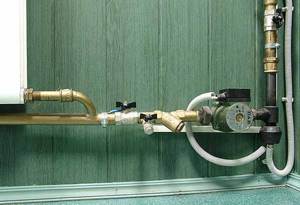
A short-term drop in pressure sometimes occurs due to the operating characteristics of the regulator, which periodically releases part of the water from the supply to the return. If the radiators heat up to the required temperature, and evenly, then the pressure drop is due to the regulator. Also, reasons for low blood pressure may be:
- decrease in water temperature;
- removal of air through vents, due to which the volume in the coolant system decreases.
Increase in pressure in the heating system: reasons and what to do?

An increase in pressure is more dangerous than a drop - in this case, damage to heating devices and accidents may occur.
There may be several reasons for the increase:
- faulty sensors - check their readings, they may simply be faulty;
- the shut-off valves are blocked somewhere - just open the taps if this is the case;
- air pockets have formed in the circuit - this can be solved with the help of installed air vents;
- clogged filters - clean or simply replace;
- excess liquid enters the circuit - the make-up valve may be leaking or not tightly closed, check it.
Increased pressure
If the maximum pressure in the heating system is exceeded, the reason for this is slowing down or stopping the movement of water in the heating circuit.
This can lead to:
- contamination of mud traps and filters;
- the occurrence of an air lock;
- replenishment of the coolant due to an automatic failure or incorrectly adjusted valves located on the supply and return (read: “Automatic recharge of the heating system - diagram of the assembly and recharge valve”);
- a feature of the regulator or its incorrect setting.
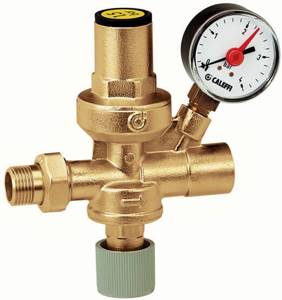
This is considered normal if, after bringing the water volume and pressure to operating levels, no deviations are observed for several weeks. Otherwise, most likely, pressure instability is associated with incorrect hydraulic calculations, including insufficient volume of the expansion tank. That is why, when installing a heating system, it is important to correctly perform all the calculations - in the future this will eliminate various problems with its functioning.
Central heating
How does an elevator unit work?
At the elevator entrance there are valves that cut it off from the heating main. Along their flanges closest to the wall of the house, there is a division of areas of responsibility between homeowners and heat suppliers. The second pair of valves cuts off the elevator from the house.
The supply pipe is always at the top, the return pipe is always at the bottom. The heart of the elevator unit is the mixing unit, in which the nozzle is located. A stream of hotter water from the supply pipe flows into the water from the return pipe, drawing it into a repeated circulation cycle through the heating circuit.
By adjusting the diameter of the hole in the nozzle, you can change the temperature of the mixture entering the heating radiators.
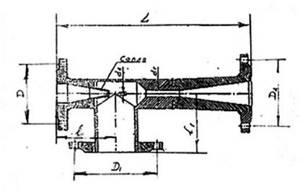
Strictly speaking, an elevator is not a room with pipes, but this unit. In it, supply water is mixed with return water.
What is the difference between the supply and return pipelines of the route?
- In normal operation it is about 2-2.5 atmospheres. Typically, 6-7 kgf/cm2 enters the house on the supply side and 3.5-4.5 on the return side.
Please note: at the exit from the thermal power plant and boiler house the difference is greater. It is reduced both by losses due to the hydraulic resistance of the routes and by consumers, each of which is, simply put, a jumper between both pipes.
- During density tests, pumps pump at least 10 atmospheres into both pipelines. Tests are carried out with cold water with the inlet valves of all elevators connected to the route closed.
What is the difference in the heating system
The difference on the highway and the difference in the heating system are two completely different things. If the return pressure before and after the elevator does not differ, then instead of supply, a mixture is supplied to the house, the pressure of which exceeds the readings of the pressure gauge on the return by only 0.2-0.3 kgf/cm2. This corresponds to a height difference of 2-3 meters.
This difference is spent to overcome the hydraulic resistance of bottlings, risers and heating devices. Resistance is determined by the diameter of the channels through which water moves.
What diameter should be the risers, fillers and connections to radiators in an apartment building?
The exact values are determined by hydraulic calculation.
In most modern houses the following sections are used:
- Heating outlets are made from pipes DN50 - DN80.
- For risers, a pipe DN20 - DN25 is used.
- The connection to the radiator is made either equal to the diameter of the riser, or one step thinner.
A caveat: you can only underestimate the diameter of the line relative to the riser when installing heating yourself if you have a jumper in front of the radiator. Moreover, it must be embedded into a thicker pipe.

The photo shows a more sensible solution. The diameter of the liner is not underestimated.
What to do if the return temperature is too low
In such cases:
- The nozzle is drilled out . Its new diameter is agreed with the heat supplier. An increased diameter will not only raise the temperature of the mixture, it will also increase the drop. The circulation through the heating circuit will speed up.
- In the event of a catastrophic lack of heat, the elevator is disassembled, the nozzle is removed, and the suction (pipe connecting the supply to the return) is turned off . The heating system receives water directly from the supply pipe. Temperature and pressure drop increase sharply.
Please note: this is an extreme measure that can only be taken if there is a risk of heating defrosting. For normal operation of thermal power plants and boiler houses, a fixed return temperature is important; By turning off the suction and removing the nozzle, we will raise it by at least 15-20 degrees.
What to do if the return temperature is too high
- The standard measure is to weld the nozzle and re-drill it, with a smaller diameter.
- When an urgent solution is needed without stopping the heating, the difference at the entrance to the elevator is reduced with the help of shut-off valves. This can be done with an inlet valve on the return line, monitoring the process using a pressure gauge. This solution has three disadvantages:
- The pressure in the heating system will increase. After all, we limit the outflow of water; the lower pressure in the system will become closer to the supply pressure.
- The wear of the cheeks and valve stem will accelerate sharply: they will be in a turbulent flow of hot water with suspensions.
- There is always the possibility of worn cheeks falling. If they completely shut off the water, the heating (primarily the access heating) will defrost within two to three hours.

The pressure is controlled by a pressure gauge on the return line. The difference is reduced to 0.5-1 kgf/cm2, no less.
Why do you need high pressure in the line?
Indeed, in private houses with autonomous heating systems, an excess pressure of only 1.5 atmospheres is used. And, of course, more pressure means much higher costs for stronger pipes and power supply for injection pumps.
The need for greater pressure is associated with the number of floors in apartment buildings. Yes, circulation requires a minimum drop; but the water needs to be raised to the level of the jumper between the risers. Each atmosphere of excess pressure corresponds to a water column of 10 meters.
Knowing the pressure in the line, it is not difficult to calculate the maximum height of a house that can be heated without the use of additional pumps. The calculation instructions are simple: 10 meters multiplied by the return pressure. A return pipeline pressure of 4.5 kgf/cm2 corresponds to a water column of 45 meters, which, with a height of one floor of 3 meters, will give us 15 floors.
By the way, hot water supply in apartment buildings is supplied from the same elevator - from the supply (at a water temperature of no higher than 90 C) or return. If there is a lack of pressure, the upper floors will remain without water.
How to calculate
Calculating the pressure in the heating system is necessary for two reasons: to ensure circulation of the coolant and to prevent depressurization of some circuit elements due to exceeding their operating pressure.
Reference. The maximum operating pressure is indicated on the components themselves or in their data sheet. For example, for polypropylene pipes this is 4-6 atm, for many cast iron radiators - 5 atm . The calculated pressure should not exceed the permissible pressure of the “weakest link” of the heating circuit.
In order for the coolant to move through the pipeline, it is necessary to create a dynamic pressure greater than static:
- In a scheme with natural circulation , it slightly exceeds the static level.
- With forced circulation , the dynamic value should be as large as possible than the static value to obtain maximum efficiency.
To determine hydrostatic pressure, the formula p = ρgh , or, simplifying for water, p = 10000h , where h is the height of the water column in the heating system.
Working pressure is defined as the sum of the static pressure at a given height of the circuit and the dynamic pressure created by the pump or the convection process. The maximum impact on the pipes is created at the lowest point of the system, while at the top it is minimal.
Types of pressure
Pressure in the heating system is divided into static and dynamic.
Static
Hydrostatic pressure is the pressure exerted by the weight of water in the system ; it depends on the height of the water column, therefore, on the number of storeys of the building. At the highest point of the contour it is zero.
Reference. For every 10 meters of height, the static pressure changes by 1 atmosphere (
Dynamic
This pressure is created primarily by circulation pumps , as well as by convection (the movement of liquid due to temperature differences) during heating.
The dynamic level is influenced, in addition to the above, by heating regulators installed on radiators and in the boiler room.
Why does pressure drop?
If the pressure in the heating boiler drops, you need to check the system for leaks. Most often the problem is related to coolant losses. There are a number of potential sources of leaks.
System make-up valve
This problem is familiar to many owners of budget wall-mounted double-circuit boilers. The plastic from which the make-up valves are made quickly “ages” from heating, and microcracks appear in it. Through them, the coolant leaves the system. In especially severe cases, the leak is visible to the naked eye, but more often the coolant leaks out in small drops, which can only be detected with a detailed inspection.
In systems with floor-standing boilers, the make-up valve is most often located at the lowest point of the heating circuit. The problem is resolved by replacing the valve with a new one.
Hydraulic group of a double-circuit boiler
Double-circuit wall-mounted boilers have several more points at which the seal may fail:
- Three-way valve stem. Water with high salt content provokes the formation of lime deposits on its surface. When the rod moves, the gland seals wear out. The problem is solved by cleaning the rod from deposits and installing new seals.
- Connections with union nuts (American). During operation of the boiler, gaskets made of some materials “shrink” and leaks appear at the joints. The problem is solved by tightening the union nuts.
We do not consider violation of the integrity of heat exchangers, since such a problem occurs extremely rarely and is most often classified as a manufacturing defect.
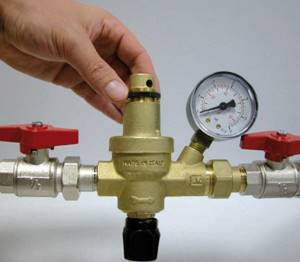
Safety valve
All systems without exception have safety valves (in the safety group or in the boiler itself). Their task is to relieve pressure in the boiler when the coolant boils in order to prevent rupture of the heat exchanger. This is a mechanical device with a return action, the main working element of which is a spring. It is compressed with a certain force. Aging and plastic deformation of the spring metal lead to the fact that this force decreases and is no longer able to hold the valve in the seat. The mechanism operates at normal operating pressures, discharging part of the coolant into the drain.
A malfunction of the safety valve can be detected during the period of heating of the coolant (during intense combustion of solid fuel or turning on the main gas burner). There is a pressure gauge in the safety group or on the boiler body. If the relief valve operates at normal pressure readings, it must be replaced.
Miniature pressure relief valves on wall-mounted boilers sometimes refuse to return to the closed position due to deposits on the body walls. Then the pressure in the gas boiler drops so quickly that the system has to be recharged several times a day. You can restore functionality to a soured valve yourself, but to do this you need to completely disassemble it. It is important not to overtighten the spring later: when unscrewing the adjusting screw, you need to count the number of turns by which it was screwed in, and when reassembling it, return it to the same position.
Expansion tank
This element of the heating system is involved in creating coolant pressure and is responsible for compensating for its thermal expansion. It is a hollow container divided by an elastic partition into air and water chambers. When the volume of liquid in a closed heating system changes, the membrane moves. Before connecting to the heating system, a certain excess pressure is created in the air chamber of the expansion tank to ensure normal operation of the heating circuit. For this purpose, it has a nipple. Wall-mounted boilers are supplied with a pre-inflated tank.
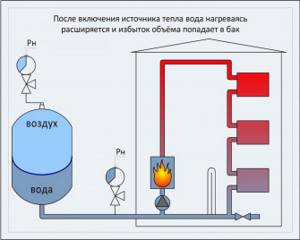
Operating principle of a membrane expansion tank
Problems with pressure in the boiler can occur in two cases:
- Nipple leakage.
The pressure drop in the boiler expansion tank on the air side leads to a pressure drop in the heating circuit. After recharging the system, it returns to normal, but during the heating cycle it rises excessively. The working volume of the air chamber is insufficient to compensate for thermal expansion. As a result, the boiler safety valve relieves pressure to a safe level, and after the coolant cools down, the situation repeats. - Membrane rupture.
The coolant enters the air chamber and the device ceases to perform its functions. Expansion tanks from some manufacturers can be repaired by replacing the membrane. Small tanks built into wall-mounted boilers most often cannot be disassembled, and they have to be replaced entirely.
To set up the expansion tank, you need to know the pressure in the air chamber. Usually the manufacturer indicates it in the equipment passport. Some models are supplied without pre-inflation. To calculate the nominal pressure for them, it is necessary to multiply the height of the water column (the difference between the highest point of the system and the installation location of the tank) in meters by 0.1 and add 0.2...0.3 to the resulting value.



